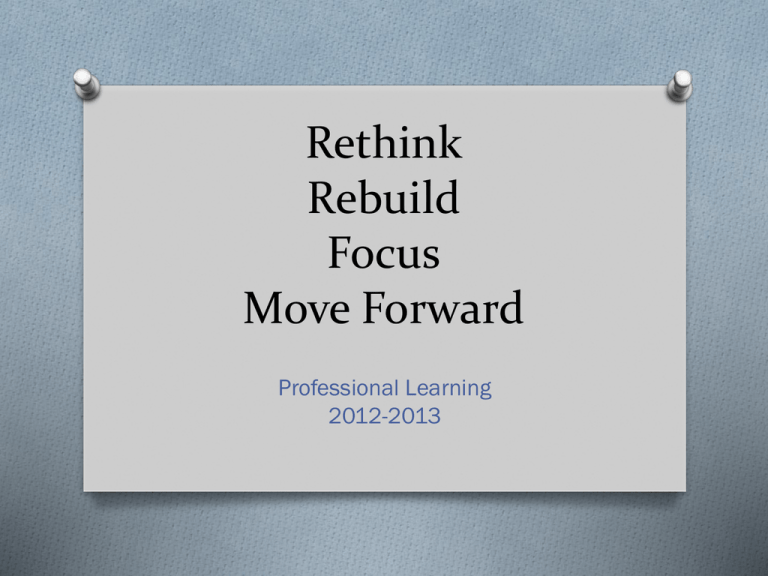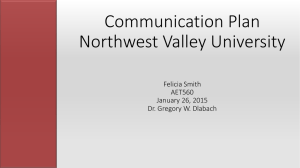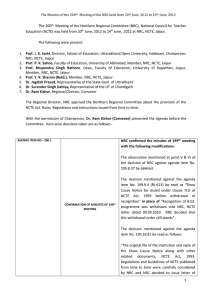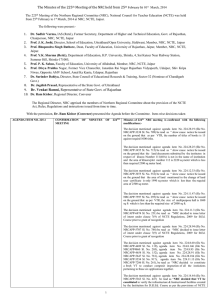File - Tarah Erickson
advertisement

Rethink Rebuild Focus Move Forward Professional Learning 2012-2013 It is the position of the MDE that quality professional learning is sustained, work-embedded learning experiences focused on teacher growth directly related to student achievement. According to Learning Professional Learning Forward one critical Opportunities component is the number of hours required to develop deep O PLC understanding and transfer to routine O Common Planning Time practice, with research O Staff Meetings landing on about 49 hours of training and O District PD follow‐up sessions, as well as team and classroom support. The Work Flow of the PLC Explore the Data Plan for instruction Peer Observation and Debrief Sessions Reexamine the Data Discuss next steps Job-Embedded Professional Development: Professional Learning Communities O O O O O Explore the data –examine student work using the protocol “Revising student work”. In October, during the first PD day teachers will analyze the spring writing assessments for their grade levels. Each grade level will define the specific problem they notice the grade-level has as a whole. After the problem is defined teachers will develop a plan to address the problem using Peha’s article The Organizers: Power-Packed Single-Page Tools for Efficient and Effective Instruction. Teachers will weave this resource in while mapping out their writing process lesson plans Peer observation – once a month, one of the three teachers in each grade level will present a demo lesson based on the plan developed during the PD day. Debrief sessions – discuss problems and potential solutions Reexamine student work, assessments, teacher observations, and progress monitoring tools Discuss problems and highlights and make adjustments to instruction and student learning How This Will Work O District mandated Professional Development Days = 15 hours These hours will be used to come together as a whole group and assess the students’ writing and discuss the results and adjustments to instruction. O Staff Meetings = 4.5 hours This time will be used for sharing what is happening in the classroom with regard writing instruction. O PLC Hours = 9 hours After school meeting will be used for research or staff needs/concerns. O Common Planning Time = 35 hours Release time will be used for peer observations, debriefing, and planning. O Common Planning Time Schedule Monday- Kindergarten 2:00-3:00 Tuesday- 1st Grade 1:00-2:00 and 5th Grade 8:20-9:20 Wednesday- 2nd Grade 12:45-1:45 Thursday- 3rd Grade 11:00-12:00 Friday- 4th Grade 12:45-1:45 Outcomes For Students For Teachers O O O O O O O Being part of a professional learning community reducing teacher isolation Increases commitment to the vision and goals of the school Creates shared responsibility for the total development of students Creates powerful learning that defines good teaching and classroom practice, and enhances understanding of course content and teacher roles. Develops a community of learners, pulls interested, willing people together Develops trust and relationships Nurtures a program of continuous learning. O O O O O Research and data show that students who use the writing process score higher on national assessments. Increased student learning and achievement Students receive feedback throughout the writing process Helps develop positive relationships between student/teacher and student/student Students benefit from the structure and security of following the writing process in their writing. References O O O O O O Gillespie, Amy., Graham, Steve. (2010) John Hopkins University School of Education New Horizons for Learning, Evidence-based practices for teaching writing. Retrieved from http://education.jhu.edu/newhorizons/Better/articles/Winter2011.html Hirsh, Stephanie. (2009). An Introduction to Professional Learning in the Learning Profession Panel presentation for American Youth Policy Forum: Rethinking professional development: Comprehensive approaches to ensuring effective teachers. Retrieved from http://www.learningforward.org/news/authors/hirsh_panel6-26-09.pdf National Center for Education Statistics. (1996). Can students benefit from process writing? (NCES 96-845). NAEP-ACTS, 1(3). Washington, DC. Retrieved from: http://nces.ed.gov/pubs96/web/96845.asp Peha, Steve. (2003). Teaching That Makes Sense, An Introduction to the Writing Process Tools and Techniques for Helping Students Turn Raw Ideas into Polished Prose Retrieved from http://www.ttms.org/ Writing Study Group of the NCTE Executive Committee . National Council of Teachers of English. (2004) NCTE Beliefs about the Teaching of Writing. Retrieved from http://www.ncte.org/positions/statements/writingbeliefs






